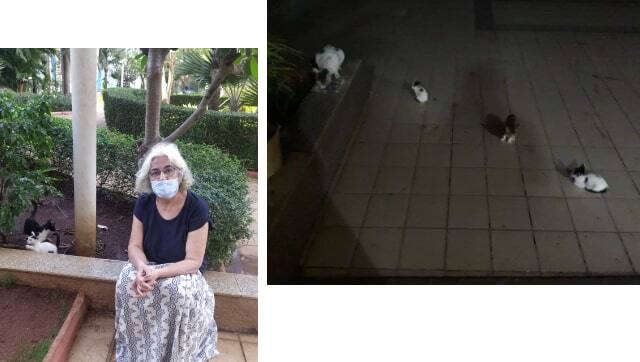Read more columns in this series here . *** Cat-aloguing the Neighbourhood Our crack commando unit is called Black Cats. I also recently discovered that, CATS is an acronym for 99 phrases, among them South Africa’s Crimes Against The State. All of us could list several Crimes Against Neighbours, but I’m still figuring out if an altercation last week can be booked under this cat-egory. The trigger was a photograph posted on the WhatsApp group of our gated community by Zubin Mehta (not THE one, but a despairing resident). Hearing strange, faint sounds emanating from the front of his car, he lifted the bonnet to find a furry bundle. Five tiny kittens peered back at him in worried bemusement. His post had asked the management committee to deal with the stray cat menace in the basement parking areas. He added a further request to the concerned residents to ‘please stop feeding them, or else keep them in your house and feed them there’. This set off yet another verbal fusillade between the society’s cat-champions, led by our Billi ki Rani, Rita Maker, and their equally dogged opponents. The comments fell into the usual polar positions: ‘Love all God’s creatures’ countered with ‘Sure, as long as they don’t mess up public spaces’. Every housing colony has the tug of war ’twixt the Pet-lovers and the Petrified (or merely Petulant). The anti-group doesn’t want to share a cramped lift with a monstrous — and jumpy — canine. The other usual grouse is over unseemly poo left behind unwittingly, unknowingly or downright uncaringly by the dog-walker. Pet cats are almost always housebound. But stray cats are quite another kettle of fish. And were the cause of our recent cat-atonic exchange. They are assiduously shooed out of swanky SoBo societies, but they easily infiltrate into large gated communities. They are anatomically designed to squeeze through the narrowest space between the railings that separate the compound from the street. It takes just one cat and a passing tom, to become a living example of Bobby Darin’s 1961 hit, ‘Multiplication’: ‘Two butterflies/Casting their eyes, /Both in the same direction. /You’d never guess/ That one little yes/ Can start a butterfly collection.’ That flitting proliferation would be universally welcome. But cats don’t emerge from caterpillars. [caption id=“attachment_9430231” align=“alignnone” width=“640”]  (L) The kittens found under the bonnet of Zubin Mehta’s car (R) Cats of Dosti Flamingos. Images: Author provided; Facebook/@Rita-Maker[/caption] Several generations now have squatting rights in our complex. They are not liable for quarterly maintenance and, unlike pesky human tenants, immune to eviction efforts. In fact, they behave more like the ‘monarch of all I survey’, strolling, stretching, sringar-ing with languid elaboration. Podium garden, clubhouse, basements, lobbies, in all our public spaces you can find an Indian version of TS Eliot’s delightful Old Possum’s Book of Practical Cats, the inspiration of Andrew Lloyd Weber’s memorable musical. Cats in every possible combination of black and white, ginger cats, calico cats, tabbies — and the fat-jowled tom who jumps down from the night-hidden boundary, shoots and leaves. Soon enough arrive those riveting kittens, the darling of little children who pet, cuddle, lug them around, and occasionally get scratched. But then you should recall the astute Ogden Nash’s observation: ‘The trouble with a kitten is that/ Eventually it becomes a cat.’ Applies to humans too. How those kittens were deposited under Zubin Mehta’s closed car bonnet will not be a mystery to anyone whose home has been the free labour room for pregnant felines. Growing up in a sprawling old house that was also my family’s printing press, it was a perennial headache to extricate the skinny, whining creatures from under the inaccessible spaces behind the racks and reams. Btw, we had inherited all these generations from the pet cat of the Nepali ayah of the adjacent house. The latter left and went back to her native hills. The cat being an urban animal merely strolled across the common terrace, and unilaterally took possession of her new home. A caterwauling street tom did the rest. The literal stray cat can be found across the history of human settlements. But I want to present it as a double metaphor. One, this feline squatter nonchalantly occupying public spaces can be seen as yet another example of encroachment, that immutable marker of urban life, regardless of socio-economic classifications. Two, the stray cat symbolises class prejudice. While that trait is as old as society itself, this one is specific to the new housing societies which now spread across gentrifying areas such as our Sewri. Their residents live in a rarified bubble totally unrelated to the raucous surroundings. The street and all its lowlier occupants — other than those who serve our needs — must be kept beyond the Lakshman Rekha of our ornate gates. The rastey ki billi is arguably the only outsider that couldn’t care two meows for our snobbery, indeed saunters around our property with a snooty air of its own. Cool cat.
Through this fortnightly column, Tales From TJ Road, Bachi Karkaria tells the story of Mumbai’s metromorphosis
Advertisement
End of Article


)
)
)
)
)
)
)
)
)



